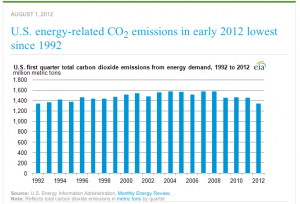A recent report done by the EIA highlighted a drop in U.S. carbon dioxide emissions from energy consumption. According to the report, these emissions are at their lowest point since 1992.
Generally, this is good news. As the summary of this finding notes, there are a number of reasons for this reduction: a mild winter (and the concomitant reduction in overall household energy consumption), a shift in fuel use in energy generation from coal to natural gas, and a drop in gasoline usage (likely still an effect of the recession).
This is a critical time in the U.S.’s move to more carbon-friendly energy sources. There is a real opportunity for us to reduce our national carbon emissions, but we also need full transparency from researchers (both academics and government) and more life-cycle accounting of the carbon emissions from the natural gas extraction process. While it is true that gas is a much less carbon-intense fuel source, there are significant potential problems with its extraction, as some experts have noted. Uncombusted natural gas has the potential to trap much more heat than CO2, so it is crucial that these losses are accounted for when doing the calculus for natural gas’ CO2 benefits.
Considering the magnitude of natural gas’ potential pros and cons, getting the public accurate, thorough information is critical (and might be tough, according to a new NRDC report). News coverage of the incomplete EIA report, and the deeply flawed “fracking is safe” report from UT-Austin’s Energy Institute (more on that here) may lead the public to assume that natural gas is an energy panacea that is not. At least not yet.











